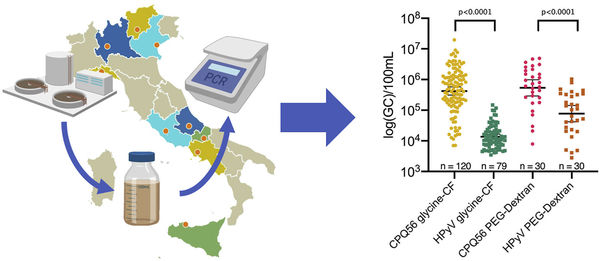
CrAssphage abundance and correlation with molecular viral markers in Italian wastewater
Abstract
Current fecal indicators for environmental health monitoring are primarily based on fecal indicator bacteria (FIB) which do not accurately represent viral pathogens. There is a need for highly abundant, human-associated viral fecal indicators to represent viral pathogens in sewage-contaminated water. In the present study, we evaluate the abundance of the emerging viral fecal indicator crAssphage in 156 Italian wastewater samples collected between 2014 and 2018. Samples were collected using two separate viral concentration methods, glycine-CF and PEG–dextran and qPCR assays were run for crAssphage (CPQ56) and Human Polyomavirus (HPyV) and endpoint PCR assays were run for Human Bocavirus (HBoc) and Hepatitis E Virus (HepE). CrAssphage was detected in 96% of samples and no statistically significant difference was observed in crAssphage abundance between concentration methods (p = 0.39). CrAssphage concentrations also did not correlate with location (latitude) or size (load and capacity) of the wastewater treatment plant. HPyV detection rates with the glycine-CF and PEG–dextran methods were 64% and 100%, respectively, and the concentrations of HPyV were statistically significantly influenced by the concentration method (p < 0.0001). CrAssphage was measured at significantly higher concentrations than HPyV for both concentration methods (p < 0.0001). The observed concentration ranges were 3.84–7.29 log10GC/100 mL for crAssphage and 3.45–5.17 log10GC/100 mL for HPyV. There was a strong positive correlation between crAssphage and HPyV abundance for both concentration methods; however, the slope of the correlation depended on the concentration method. CrAssphage presence correlated with the presence of HBoc in samples concentrated with glycine-CF, but did not correlate with the presence of HBoc concentrated with the PEG–dextran method or with the presence of HepE. Overall, these results demonstrate that crAssphage is an abundant viral fecal indicator in wastewater with statistically significant correlation with human viral pathogens (e.g., HPyV) and viral concentration methods influence the interpretation of fecal viral indicator detection.
Link
https://www.sciencedirect.com/science/article/abs/pii/S0043135420306989